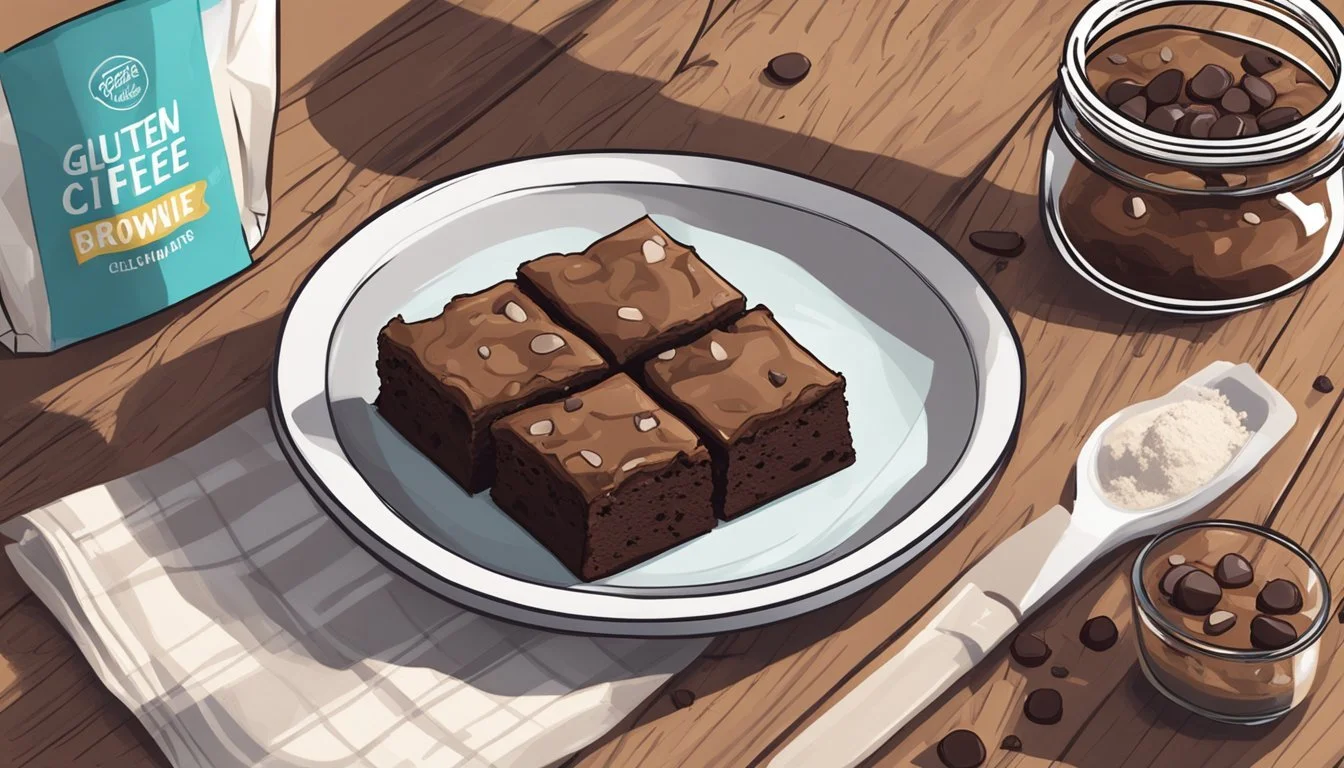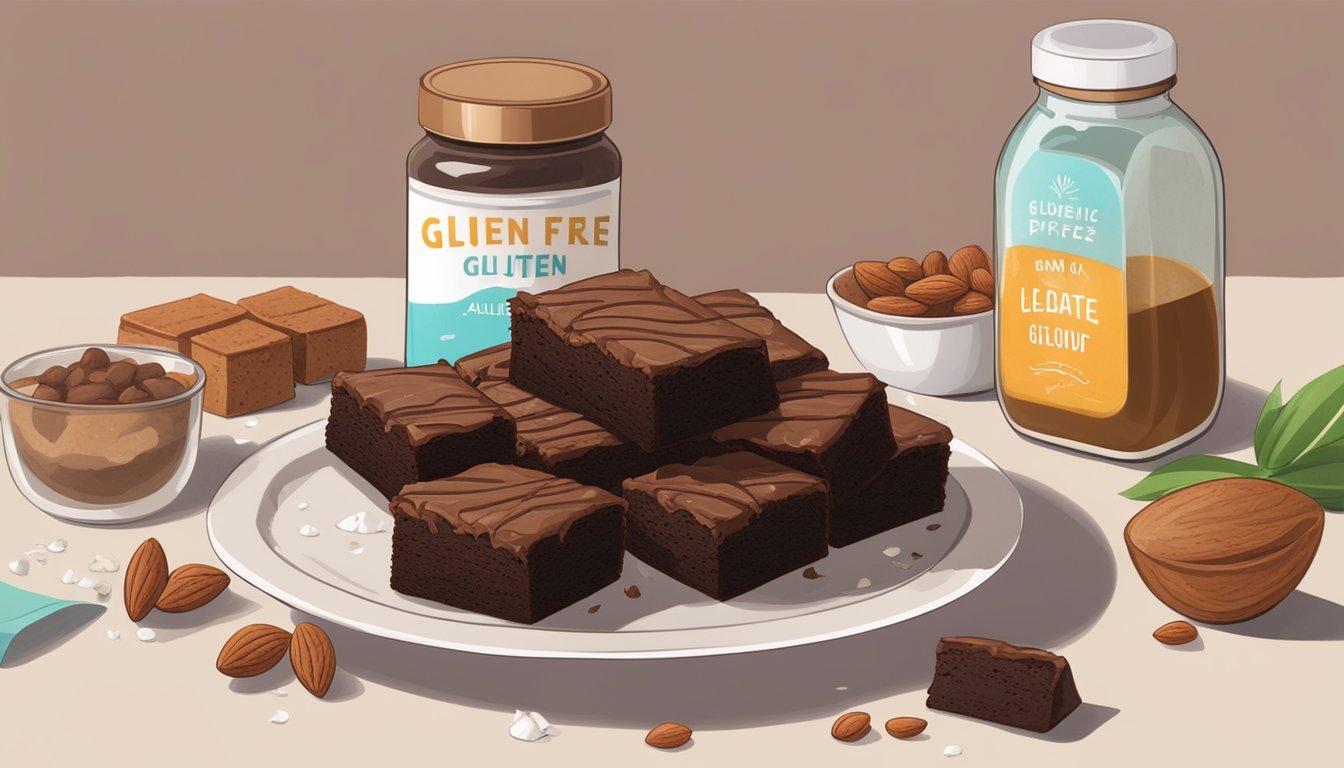Are Brownies Gluten-Free?
Understanding Their Ingredients and Variations
Classic brownies are typically made with ingredients that contain gluten, which is a protein found in wheat, barley, and rye. This means that traditional brownie recipes are not suitable for those with celiac disease or a gluten sensitivity. However, with the increasing demand for gluten-free options, many recipes and ready-made gluten-free brownie mixes have become available to cater to those avoiding gluten.
Gluten-free brownies can achieve the same rich and fudgy texture as their gluten-containing counterparts by substituting regular flour with gluten-free flour blends. These blends often incorporate a mix of rice flour, potato starch, and other gluten-free grains to mimic the structure provided by gluten. Care also must be taken with the rest of the ingredients to ensure they do not contain or have come into contact with gluten, as cross-contamination can occur very easily.
When preparing gluten-free brownies, bakers have the option to enhance flavor and texture with various ingredients. Add-ins like nuts, chocolate (What wine goes well with chocolate?) chips, and cocoa powder, as long as they're certified gluten-free, can elevate the basic brownie to a more indulgent treat. Ensuring all the ingredients are gluten-free allows those with dietary restrictions to enjoy brownies without concern.
Understanding Gluten-Free Baking
When approaching gluten-free baking, it is essential to have a clear understanding of gluten-free ingredients and how they interact differently from traditional wheat-based components.
What Does Gluten-Free Really Mean?
Gluten-free baking excludes the protein gluten, which is found in wheat, barley, and rye. Therefore, traditional flours are replaced with gluten-free alternatives. Gluten provides elasticity and structure to baked goods, so gluten-free recipes must compensate for its absence to achieve a desirable texture.
Gluten-Free Flours and Blends
Gluten-free flour options vary, including almond flour, rice flour, and high-quality gluten-free flour blends. A high-quality gluten-free flour blend often combines several flours to mimic the properties of wheat flour. For instance, a blend could contain rice flour for its neutral flavor and almond flour for added moisture retention. When selecting a gluten-free flour or blend, bakers should consider the desired outcome of their baked good, as each flour has unique properties.
Rice Flour: Lightweight and slightly gritty, good for neutral taste.
Almond Flour: Adds moisture, but has a distinctive flavor.
The Importance of Xanthan Gum
In gluten-free baking, xanthan gum acts as a substitute for gluten by providing the stickiness and elasticity needed for baked goods to hold together and maintain a pleasing texture. Typically, a quarter to half a teaspoon per cup of flour is sufficient. Baking powder and baking soda might also be added to provide leavening and lift, counteracting the sometimes denser nature of gluten-free baked goods. Here is how much xanthan gum is usually recommended for different types of baked goods:
Baked Good Xanthan Gum Amount Cookies 1/4 tsp per cup of flour Cakes and Muffins 1/2 tsp per cup of flour Breads and Pizza Dough 1 tsp per cup of flour
Essential Ingredients for Gluten-Free Brownies
Selecting the right ingredients is crucial to achieving delicious gluten-free brownies. It involves careful choice of fats and sugars, using eggs as a binder, and deciding between cocoa powder and chocolate, all while ensuring that all components comply with gluten-free standards.
Choosing Your Fats
For gluten-free brownies, the type of fat used can significantly influence the texture and flavor. Butter is a traditional choice that imparts richness, but for dairy-free options, one may opt for coconut oil or vegan butter. Each fat brings a unique profile to the brownies; coconut oil will provide a slight coconut flavor, while vegan butter aims to mimic the taste of traditional butter.
Selecting the Right Sugars
The sugar incorporated into brownie batter not only sweetens the treat but also affects its texture. Regular white sugar will give a lighter texture, while brown sugar with its molasses content offers moisture and a deeper flavor. Some recipes might blend both to capture the benefits of each.
Eggs: The Binding Agent
Eggs serve as a vital binding agent in gluten-free brownie recipes. They provide structure and stability to compensate for the lack of gluten. It's important for the baker to beat them well to ensure proper aeration and to help create a smooth, cohesive batter.
Cocoa Powder Versus Chocolate
The choice between cocoa powder and chocolate depends on the desired result. Unsweetened cocoa powder yields a rich, intense chocolate flavor, while melted chocolate contributes to the creaminess and depth of the brownies. Some bakers use both for a complex chocolate experience, with optional chocolate chips for added texture and richness. Using quality vanilla extract can also enhance the chocolate flavor.
The Perfect Brownie Recipe
Crafting the perfect gluten-free brownie recipe requires precision and attention to detail. This section provides a detailed guide to ensuring that the brownies come out moist, fudgy, and delectable every time.
Step-by-Step Instructions
Prep the Baking Pan: Line an 8-inch square metal baking pan with parchment paper, leaving overhang for easy removal.
Mix Dry Ingredients: In a medium bowl, sift together almond flour, cocoa powder, baking powder, and a pinch of salt.
Combine Wet Ingredients: Melt butter with sugar in a saucepan, then cool slightly. Whisk in eggs, vanilla extract, and any additional flavorings.
Combine Mixtures: Gradually stir the wet ingredients into the dry ingredients until just combined. Fold in chocolate pieces if desired.
Prepare for Baking: Spread the batter evenly in the prepared pan.
Adjusting for Altitude and Humidity
High Altitude: Increase oven temperature by 25°F and reduce baking time slightly. Add an extra tablespoon of flour to stabilize the batter.
Humidity: In humid conditions, decrease the amount of liquid in the recipe by a few tablespoons to counteract the additional moisture in the air.
Baking Times and Techniques
Preheat the Oven: Ensure the oven reaches 350°F before baking.
Bake Time: Gluten-free brownies typically require 30-35 minutes in the oven. For chewier brownies, slightly shorten the cooking time.
Bake Mode: Use the standard bake mode to provide even heat distribution.
Testing for Doneness
Toothpick Test: Insert a toothpick into the center of the brownies. It should come out with a few moist crumbs attached, not completely clean.
Visual Cues: Look for a shiny, crackled top and check that the edges have started to pull away from the sides of the pan.
Texture and Flavor Variations
In gluten-free brownie recipes, the texture and flavor can be adjusted by manipulating the ingredients and baking techniques used. These variations can yield brownies that are either fudgy or cake-like, and flavors can range from rich chocolate to a melody of spices and mix-ins.
Fudgy Versus Cakey Brownies
The texture of brownies falls into two main categories: fudgy and cake-like. Fudgy brownies have a higher fat-to-flour ratio, typically incorporating more butter and chocolate, which results in a dense, moist, and chewy texture. They often contain less flour and use whole eggs. In contrast, cake-like brownies include more flour and a leavening agent like baking powder, which gives them a lighter, airier structure with a more tender crumb.
Mixing in Nuts, Chips, and Other Add-ins
Gluten-free brownies can be customized with a variety of mix-ins to create unique textures and flavors. Nuts such as walnuts or pecans provide a crunchy contrast to the soft brownie base, while chocolate chips or toffee bits add pockets of melted sweetness or a caramel crunch. Consider the following blend-ins for added texture:
Chopped nuts (walnuts, pecans)
Chocolate chips
Toffee bits
Mix-ins should be folded into the batter gently to prevent overmixing, which can affect the texture of the brownies.
Incorporating Flavors and Spices
Beyond chocolate, gluten-free brownies can be infused with various flavors and spices to enhance the overall experience. The rich chocolate flavor of brownies pairs well with espresso powder, which can deepen the chocolate taste. Alternatively, spices like cinnamon or vanilla extract can add a subtle warmth and complexity. Use spices judiciously to complement rather than overpower the brownie's chocolatey profile.
Serving and Storing Gluten-Free Brownies
When it comes to gluten-free brownies, proper serving and storage techniques ensure that they retain their texture and flavor. Here are some tips to maximize enjoyment and shelf-life of your gluten-free treats.
Cutting and Serving Tips
For cutting gluten-free brownies, it is best to let them cool completely in their baking pan on a wire rack. A cool brownie cuts into neater squares reducing crumbs and ensuring that every piece holds its shape. A plastic knife or a sharp knife heated under hot water and then dried can make slicing easier.
When serving, consider the texture preference of your guests; if fudgy, serve at room temperature; for a firmer texture, one may refrigerate the brownies briefly. Pairing the right sides can enhance the experience; gluten-free brownies served with a scoop of ice cream can be delightful, and brownies intended to be bars can be cut into larger pieces.
Storing for Freshness
To store gluten-free brownies, keep them in an airtight container at room temperature for up to three days for optimal moistness and texture. To extend freshness, refrigerating them is also an option, wherein they can last up to a week when stored properly. Place a sheet of parchment paper between layers to prevent sticking.
For longer storage, wrapping each brownie individually before placing them in the container can help preserve their moisture and prevent them from absorbing other flavors or odors from the refrigerator.
Freezing and Reheating
Freezing is an excellent way to extend the life of gluten-free brownies. They can be frozen for up to three months. Wrap individual brownies in plastic wrap and then again in aluminum foil to prevent freezer burn.
To reheat frozen brownies, one should thaw them at room temperature or use a microwave if in a hurry. For a microwave, using short intervals and checking frequently prevents overcooking. If one prefers to revive the crisp edges that fresh brownies have, a conventional oven or toaster oven is ideal for reheating them briefly at a low temperature.
Dietary Considerations and Substitutions
When making brownies that cater to specific dietary needs, one needs to thoughtfully choose ingredients that substitute for common allergens and dietary restrictions without compromising taste and texture.
Making Brownies Dairy-Free or Vegan
To make brownies dairy-free or vegan, traditional dairy products can be replaced with plant-based alternatives. Dairy-Free Milk such as almond milk or soy milk can substitute cow's milk. Vegan Butter or coconut oil can be used in place of regular butter. When it comes to eggs, flax eggs or commercially available vegan egg substitutes work well to bind the ingredients.
Sugar and Fat Substitutes
Replacing sugar and fats in brownies is possible for those seeking lower-calorie or different dietary options. Sugar can be substituted with natural sweeteners like pure maple syrup or agave nectar. For fats, applesauce or mashed avocado can be used to reduce the recipe's fat content while still retaining moisture.
Nut-Free and Allergen-Friendly Options
For those with nut allergies, finding suitable replacements for common nut-based ingredients in gluten-free recipes is essential. Nut-Free Options can include seeds such as sunflower seed butter as a sub for nut butters. Chocolate chips used should be confirmed as allergen-free, meaning they are processed in a facility that doesn't handle nuts or other common allergens. To ensure safety, one should always review allergen programs and labels of all ingredients used.
In each case, proper measurement and even distribution of these substitutes ensures the brownie retains its classic texture and flavor.
Baking Equipment and Techniques
When crafting gluten-free brownies, the choice of equipment and execution of techniques are pivotal to achieving the perfect texture and taste. The correct bakeware, preparation methods, and mixing techniques can make the difference between good and great brownies.
Choosing the Right Bakeware
The bakeware you choose has a direct impact on your brownies' outcome. A metal pan is typically recommended for a chewy edge, while glass might lead to softer sides. For gluten-free brownies, a standard size is an 8" square pan or a 9" round pan, both at least 2" deep. Consider using a nonstick metal baking pan for even heat distribution.
Prepping Your Pan
Before mixing your ingredients, it's essential to prepare your pan to prevent sticking. Line your pan with parchment paper and secure it with nonstick cooking spray. Some bakers prefer to also grease the bottom and sides of the pan with butter or a cooking spray before placing the parchment, ensuring an extra layer of non-stick protection.
Mixing and Whisking Techniques
For the batter, start with a microwave-safe bowl or saucepan to combine your ingredients like sugar and butter. This can help with dissolving the sugar properly, which is crucial for a smooth texture. Use a whisk for combining liquid ingredients and a spatula for folding in the flour and other dry ingredients. One aims for a consistent mixture without overmixing, which can affect the chewiness of the brownies. A mixing bowl should suffice for bringing together all the ingredients following an orderly sequence.
Troubleshooting Common Gluten-Free Baking Issues
Transitioning to gluten-free baking can introduce an array of issues such as dryness or grittiness, over or underbaking, and dense or crumbly textures. Understanding how to navigate these challenges is crucial for achieving delicious, well-textured brownies.
Dealing with Grittiness or Dryness
A common complaint in gluten-free baking is the grittiness or excessive dryness in the finished product. To combat this, bakers should:
Select the Right Flour Blend: Use a finely ground gluten-free flour blend designed for baking to reduce grittiness.
Hydrate Flour Properly: Allow the dough or batter to rest before baking, enabling the flours to fully hydrate and lessen a gritty texture.
Increase Moisture: Incorporate ingredients with natural moisture, such as applesauce or pureed pumpkin, to add moistness and improve the overall texture.
Solving Under or Overbaking Problems
Ensuring that gluten-free brownies are baked properly is crucial to avoid an uncooked center or a burnt exterior. Tips include:
Oven Calibration: Verify the accuracy of the oven temperature with an external thermometer.
Adjust Baking Time: Gluten-free baked goods may require more time. Start checking for doneness a few minutes before the recommended time.
Use a Light-Colored Pan: Dark pans can absorb more heat, leading to overbaking. Light-colored pans reflect heat, offering a gentler baking process.
Fixing Crumbly or Dense Textures
Gluten-free brownies can sometimes turn out overly crumbly or dense instead of having that desired fudgy or chewy texture. Here's what bakers can do:
Xanthan Gum or Psyllium Husk: Incorporate binders like xanthan gum or psyllium husk to improve structure and reduce crumbliness.
Correct Leavening Agent Ratios: Balance baking soda and baking powder to ensure proper rise without making the brownies too dense.
Don't Overmix: Mix the batter just until the ingredients are combined. Overmixing can lead to dense and heavy brownies.
Tips for the Perfect Gluten-Free Brownies
Making the perfect gluten-free brownies involves paying attention to the preparation of the batter and the baking process to achieve that desirable chocolatey taste and texture. Here, we offer specific guidance on creating a crackly top, ensuring a moist and chewy middle, enhancing the chocolate flavor, and utilizing quick and easy recipes.
Secrets to a Crackly Top
One wants to mimic the classic brownies' signature crackly top even when working with gluten-free recipes. To do so:
Use high-quality chocolate: Melting chocolate, rather than just cocoa powder, contributes to the fat content which helps create a shiny, crackly top.
Whisk the eggs and sugar vigorously: Before adding to the batter, whisking these ingredients together until they lighten in color and increase in volume can cause the thin meringue-like layer on top.
Achieving a Moist, Chewy Texture
The texture of gluten-free brownies should be just as satisfying as their gluten-containing counterparts.
Avoid overbaking: Check the brownies a few minutes before the recipe's stated baking time to prevent them from becoming too dry.
Under-bake slightly: Removing brownies from the oven when a toothpick comes out with a few moist crumbs attached rather than completely clean ensures a fudgy inside.
Enhancing the Chocolatey Taste
An intense chocolate flavor is essential for any brownie, and gluten-free versions are no exception.
Choose quality cocoa powder: Opt for a high-quality, unsweetened cocoa powder for a robust chocolate base.
Add chocolate chips: Mixing in a handful of chocolate chips not only provides texture but boosts the chocolatey taste throughout the brownies.
Quick and Easy Recipes
Gluten-free brownies don't have to be complicated.
Opt for a simple ingredient list: Easy recipes often require fewer ingredients. Stick with the essentials like gluten-free flour, eggs, sugar, cocoa powder, and butter or oil.
Prep ahead: Measure out dry ingredients and combine them ahead of time for quicker assembly when ready to bake.
By following these tips with care, one can bake delicious servings of gluten-free brownies that offer all the decadent qualities of traditional brownies without the gluten.










